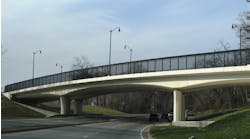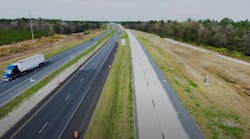Imagine what a recipe would look like for an impossible project.
Start with the basic ingredient of a complex reconstruction and widening plan. Add a tight time schedule. Mix in some bitterly cold winter weather, and then dump in torrential downpours in the spring. Stir things up even more with the important detail of this project being in the busiest traffic corridor in the state of Wyoming.
The result is not what most people would expect. This award-winning project was not only completed ahead of schedule, but also earned significant incentives for smoothness, time and quality.
The project was the reconstruction and widening of State Highway 59 from Donkey Creek (to the south) to the I-90 interchange in Gillette, Wyo. (to the north). With an annual average daily traffic (AADT) of 38,000, Highway 59 carries the most traffic of all the highways and streets in Wyoming. Because of the importance of this highway, four lanes of traffic (two in each direction) and all turn lanes were maintained at all times.
The project required intense planning, coordination and cooperation among the contractor, Concrete Works of Colorado Inc., the owner (the city of Gillette, Wyo.), and the engineer, WWC Engineering.
Equally important was the close coordination and communications with a number of other organizations, including the Wyoming Department of Transportation (WYDOT), other contractors and subcontractors, private utility companies, business owners and members of the community.
Increasingly complex
The project involved removal of severely distressed asphalt pavement and then placement of more than 81,000 sq yd of 9-in. concrete pavement. The project scope included widening of Highway 59 though the city of Gillette and was equal to 10 lanes (three through lanes in each direction, as well as double left-turn lanes at all intersections and shoulders).
Adding to the complexity of the project was the sub-base preparation, which included excavation of some 50,000 cu yd of unclassified material and muck, with as much as 8 ft of unsuitable materials being removed and replaced in some areas. Twelve inches of crushed rock sub-base and 4 in. of crushed rock base course were placed on a geogrid of geotextile fabric.
Also adding to the complexity were the addition of significant underground utilities (storm sewer, storm-water treatment devices, box culverts, etc.), as well as the overhead utilities (street lighting along the entire length of the project and new signalization of seven intersections).
Success and sub-success
The project was constructed in numerous phases and subphases that required more than 25 individual bulkheads in both the northbound and southbound directions. In spite of the phases and subphases, the contractor was able to achieve consistent smoothness on all the sections.
Also included in the project were 8,600 ft of 12-in. to 48-in. reinforced concrete pipe; 3,100 ft of 6-ft x 3-ft precast box culvert; 175 ft of 12-ft x 6-ft precast box culvert; 10,000 ft of edge drain; and over 10,000 ft of new curb-and-gutter.
The contractor also placed a 10-ft-wide sidewalk and bike path on both sides of the street for the full length of the project, as well as a raised, colored concrete median and median skirt. There were seven fully signalized intersections and new street lighting added along the entire corridor. Concrete was supplied using both a mobile plant onsite and a fixed batch plant within 10 miles of the project site. Mixer trucks were used to haul all of the concrete.
Most of the concrete pavement was placed with a GOMACO slipform paver, although the intersection pavements and tie-in pavements were placed by hand.
Tracking mud
In addition to the scale and complexity of the project, there were other unusual, often unpredictable, occurrences that could have slowed the project. The weather was a significant factor. The project began in January as a means of meeting the aggressive schedule. Workers faced a bitterly cold winter, complete with many days of 0° temperatures and high winds.
The harsh winter eventually gave way to spring, which unleashed a punishing barrage of “monsoon” rains and high winds throughout the spring and summer. On several occasions, the soil was flooded so badly that it had to be reworked or replaced, depending on the severity of the situation. As mentioned previously, a significant amount of muck excavation was required in large areas where the existing subgrade was unsuitable. Some of these excavations were more than 8 ft deep, and much of the work was done adjacent to heavy traffic.
The schedule was yet another factor that made this project so challenging. Because of meeting early completion milestones, the contractor earned the full early completion incentive bonus of $1 million.
$72,000 for 50
Smoothness was tested using a high-speed California profilograph using a 0.1-in. blanking band. For smoothness testing, the pavement was divided into 57 1?10-mile segments, each one lane wide.
The maximum profile index was 60. Acceptance with no pay adjustment was in the range of 26-36; greater than 60 would have required grinding of the entire segment. The potential bonus on a segment was less than 10 in./mile with no grinding. The average smoothness before corrective measures was 6.5 in./mile and 6.25 in./mile after corrective measures.
As a result, the contractor earned 85% of the maximum smoothness incentive for a total of $72,000 on 50 of the 57 segments.
Acceptance criteria followed WYDOT requirements for thickness, air, gradations, slump and compressive strength. All the concrete placed met or exceeded the acceptance requirements, and no pay deductions were assessed. In addition, a quality incentive bonus of $86,400 was earned for pavement thickness.
Everybody’s talking
As noted, one of the keys to the success of the project was the attention to coordination and communication with businesses and the general public. The team made contact with all of the 80 business owners affected by the project, and the lines of communication were kept open prior to construction and through completion, using both fliers and daily personal contact.
Local media were very interested in the project and covered it from beginning to end. The media coverage was very favorable, largely because of the speed at which the project was completed.
The city of Gillette staff also received regular briefings, and they in turn kept the City Council and local residents informed.
Weekly project meetings proved to be an exceptional team-building tool, as well as a means of communicating and resolving problems encountered along the way. At these meetings, a real-time weekly update was provided to WYDOT, and the same update also was shared with the local newspaper and radio station.
The personal interaction between WYDOT, Concrete Works of Colorado project personnel and all affected businesses before and during the project also were vital to the project success.
All is what it’s about
The complexities of the project, the harsh weather conditions and the tight schedule proved to be challenges throughout the project, but none of those factors was a match for the tenacity, dedication and hard work of all involved. The contractor earned significant smoothness incentives and an early completion bonus. Thanks to the team effort, the city and its residents have a durable roadway that will provide years of service and will keep traffic moving efficiently through this important corridor.
This project received a gold award in the category of Municipal Streets & Intersections (Greater than 30,000 sq yd) in the American Concrete Pavement Association’s 20th Annual Excellence in Concrete Pavement Awards, as well as a comparable local award presented by the ACPA Colorado-Wyoming Chapter.


